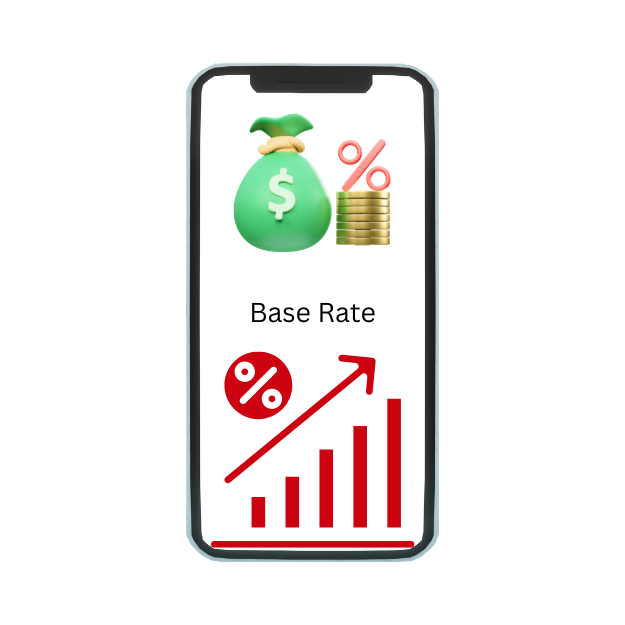Ever wondered why your home loan interest rate doesn’t budge even when the Reserve Bank of India (RBI) cuts rates? Or why your friend’s loan seems cheaper even though you both borrowed around the same time? The answer often lies in something called the base rate, a term that sounds technical but has a very real impact on your wallet.
What Is Base Rate?

Imagine you are shopping for groceries. The store has a minimum price for rice, say ₹50/kg. No matter how good your bargaining skills are, they won’t sell it below that. That minimum price is like the base rate in banking. In banking terms, the base rate is the lowest interest rate a bank can charge you for a loan. It’s set by each bank but guided by RBI rules. Introduced in July 2010, it replaced the older BPLR system, which was often inconsistent and opaque. So, if a bank’s base rate is 9%, it can’t give you a loan at 8.5%, unless it’s under a special scheme allowed by the RBI. Lets understand base rate meaning and its purpose for a better clarity.
Meaning and Purpose
The base rate is a fundamental financial benchmark used as the starting point for calculating interest rates and pricing financial products. It reflects the minimum return or interest that lenders or investors expect when evaluating the risk of a transaction. Typically set by central banks, the base rate influences borrowing costs across the economy. It plays a critical role in risk assessment, investment decision-making, and determining the cost of credit, thereby affecting financial markets and broader economic activity.
Purpose of Bank Rates
- Monetary Policy Implementation :
Central banks use the bank rate to control inflation and stabilize the economy. By raising or lowering the rate, they influence the cost of borrowing and liquidity in the financial system.
- Regulating Credit Availability
A higher bank rate makes borrowing more expensive for commercial banks, which in turn pass on the cost to consumers and businesses, reducing credit demand. A lower rate encourages borrowing and investment by making loans cheaper.
- Influencing Interest Rates in the Economy
The bank rate serves as a reference point for other interest rates, including those on loans, deposits, and bonds. It helps align market rates with the central bank’s policy objectives.
- Controlling Inflation
When inflation is high, central banks may increase the bank rate to discourage excessive spending and borrowing. Conversely, during economic slowdowns, lowering the rate can stimulate demand and growth.
- SignalingEconomic Direction
Changes in the bank rate send signals to markets about the central bank’s view on economic conditions. It helps guide expectations around future inflation, growth, and currency stability.
Calculation of Base Rate
If you are running a restaurant ,you will consider factors such as rent, ingredients, staff salaries, and your own earnings before setting menu prices. Banks do the same when setting the base rate.
The base rate is calculated by each bank individually, but within a framework prescribed by the Reserve Bank of India (RBI). It reflects the minimum interest rate below which banks cannot lend, ensuring transparency and consistency in loan pricing.
Component | Description |
Cost of Funds | The average interest banks pay on deposits and borrowings |
Operating Expenses | Costs related to running banking operations (e.g., salaries, infrastructure) |
CRR Cost | The cost of maintaining the Cash Reserve Ratio (CRR) with RBI |
Minimum Rate of Return | The profit margin banks expect from lending |
Base Rate Formula
Base Rate = Cost of Funds + Operating Expenses + Cost of CRR + Profit Margin
Example Base Rate Calculation
Let’s assume a bank is calculating its base rate for the upcoming quarter. It considers the following components:
Component | Value (%) | Explanation |
Cost of Funds | 6.50% | Weighted average interest paid on deposits and borrowings |
Operating Expenses | 1.00% | Costs of running banking operations |
Cost of CRR | 0.25% | Opportunity cost of maintaining reserves with RBI |
Minimum Profit Margin | 1.25% | Desired return on lending |
Total (Base Rate) | 9.00% | Sum of all components |
This 9.00% becomes the minimum lending rate for most loans.
- Banks cannot lend below this rate unless in special cases (e.g., loans to employees or priority sectors).
- The base rate is reviewed quarterly and adjusted based on changes in funding costs or RBI policy.
What is MCLR?
MCLR (Marginal Cost of Funds-based Lending Rate) is the minimum interest rate below which a bank is not permitted to lend, except in certain cases allowed by the RBI. It was introduced in April 2016 to replace the base rate system, aiming to improve transparency and ensure faster transmission of RBI’s monetary policy to borrowers.
Consider MCLR just like a school’s annual fee structure:
The school sets fees based on current costs (teachers’ salaries, rent, etc.). If costs drop, next year’s fees may be lower, but only for students enrolling or renewing that year. Similarly, MCLR adjusts monthly, but your loan rate changes only at the next reset date.
MCLR Formula
MCLR = Marginal Cost of Funds + Tenor Premium + Operating Costs + Cost of CRR
Let’s say a bank is calculating its 1-year MCLR. It considers the following components:
Component | Value (%) | Explanation |
Marginal Cost of Funds | 6.80% | Weighted average cost of new deposits and borrowings |
Tenor Premium | 0.10% | Extra charge for longer loan duration |
Operating Costs | 0.50% | Administrative and servicing expenses |
Negative Carry on CRR | 0.20% | Opportunity cost of maintaining reserves with RBI |
Total MCLR (1-Year Tenor) | 7.60% | Sum of all components |
- This 7.60% becomes the benchmark rate for loans with a 1-year reset frequency.
- The actual loan interest rate = MCLR + Spread (spread depends on borrower’s risk profile).
- MCLR is reviewed monthly, making it more responsive to repo rate changes than the older base rate system.
Base Rate v/s MCLR Rate
Feature | Base Rate | MCLR (Marginal Cost of Funds-based Lending Rate) |
Introduced | July 2010 | April 2016 |
Benchmark Basis | Average cost of funds | Marginal (incremental) cost of funds |
Responsiveness to Policy | Less responsive to RBI’s repo rate changes | Directly linked to repo rate; more responsive |
Tenure Sensitivity | Single rate for all tenures | Different rates for different loan tenures |
Transparency | Moderate transparency | Higher transparency in rate setting |
Review Frequency | Quarterly | Monthly |
Components Considered | Operating costs, CRR cost, minimum return | Repo rate, operating costs, CRR cost, tenor premium |
Applicability | Loans sanctioned before April 2016 | Loans sanctioned after April 2016 |
Responsiveness to Interest Rate Changes
Base rate loans adjust slowly to RBI policy changes, often delaying benefits from rate cuts. MCLR loans, revised monthly, respond faster to repo rate movements, allowing borrowers to enjoy lower EMIs sooner during easing cycles.
Impact on EMI and Total Interest Paid
Due to slower rate adjustments, base rate loans often result in higher EMIs and greater total interest over time. MCLR loans typically offer quicker rate reductions, helping borrowers save significantly on long-term interest costs.
Switching Between Systems
Borrowers under the base rate regime can request a switch to MCLR, often without fees. This move can lower interest rates and EMIs, especially when MCLR is more favorable. However, it’s important to assess the spread and reset frequency before switching.
Transparency and Predictability
Base rate calculations are less transparent, making it harder for borrowers to anticipate changes. MCLR offers clearer rate structures and scheduled resets, enabling better financial planning and predictability in loan repayments.
Loan Tenure and Reset Frequency
Base rate loans offer limited flexibility in rate resets. MCLR allows borrowers to choose reset intervals (e.g., 6-month or 1-year), aligning loan terms with personal cash flow needs and interest rate expectations.
Current & Historical Data For Base Rates
Bank Name | Base Rate (Jul 2010) | Base Rate (Jan 2015) | Base Rate (Jan 2020) | Base Rate (Aug 2025) |
SBI | 7.50% | 9.85% | 8.15% | 10.10% |
HDFC Bank | 7.75% | 9.70% | 8.30% | 9.45% |
Axis Bank | 7.75% | 10.25% | 8.50% | 10.15% |
PNB | 8.00% | 10.00% | 8.25% | 9.30% |
Bank of Baroda | 8.00% | 9.65% | 8.20% | 9.35% |
Current MCLR Rates (as of August 2025)
Bank Name | Overnight | 1 Month | 3 Months | 6 Months | 1 Year | 2 Years | 3 Years |
SBI | 8.20% | 8.45% | 8.50% | 8.85% | 8.95% | 9.05% | 9.10% |
ICICI Bank | 7.85% | 7.90% | 8.15% | 8.35% | 8.40% | — | — |
Axis Bank | 9.15% | 9.15% | 9.25% | 9.30% | 9.35% | 9.45% | 9.50% |
HDFC Bank | 9.05% | 9.10% | 9.20% | 9.35% | 9.40% | 9.40% | 9.40% |
PNB | 8.30% | 8.35% | 8.55% | 8.75% | 8.90% | — | 9.20% |
Bank of Baroda | 8.15% | 8.35% | 8.50% | 8.75% | 8.95% | — | — |
Application & Impact
For borrowers, the application of MCLR means their loan interest rate is recalibrated periodically based on the bank’s marginal cost of funds, tenor premium, and operating costs. This dynamic pricing mechanism ensures that changes in the RBI’s monetary stance are more quickly reflected in loan rates. The impact is tangible: during rate-cut cycles, borrowers experience reduced EMIs and lower overall interest burden. Conversely, during rate hikes, the upward adjustment is also quicker, requiring borrowers to actively monitor reset schedules and plan accordingly.
Switching to MCLR
Borrowers with existing base rate loans can formally request their bank to migrate to the MCLR system. While the RBI mandates that banks allow this switch without charging fees, some institutions may impose nominal administrative costs. Before switching, borrowers should compare their current base rate with the applicable MCLR plus spread, and evaluate the reset frequency (e.g., annual or semi-annual). A well-timed switch can lead to immediate EMI reductions and long-term savings, especially in a declining interest rate environment. However, borrowers should also consider future rate volatility and their own risk tolerance before making the transition.
Conclusion
- The Base Rate system, introduced in July 2010, was a pivotal reform aimed at improving transparency and fairness in loan pricing across Indian banks. By setting a minimum lending rate, it ensured that banks couldn’t lend below a certain threshold, thereby protecting borrowers from arbitrary interest charges.
- While the base rate brought structure to lending practices, its reliance on average cost of funds made it slow to respond to RBI’s policy rate changes. This limited its effectiveness in transmitting monetary policy benefits to borrowers, especially during rate cuts. As a result, the RBI introduced MCLR in 2016 and later EBLR in 2019, both designed to offer faster and more transparent rate transmission.
- For borrowers still under the base rate regime, switching to MCLR or EBLR may offer better alignment with market rates and potential EMI savings. However, this decision should be weighed against factors like conversion fees, reset frequency, and rate volatility.
- In today’s lending environment, the base rate is largely a legacy benchmark. Understanding its structure and limitations helps borrowers make informed choices about refinancing or switching to more dynamic rate regimes that better reflect current economic conditions.
Frequently Asked Questions
The base rate is the minimum interest rate set by a bank below which it cannot lend to customers (except in specific cases). It was introduced by the RBI in July 2010 to improve transparency in loan pricing.
To replace the opaque BPLR (Benchmark Prime Lending Rate) system and ensure fair, transparent, and consistent pricing of loans across banks.
It’s based on four components:
- Cost of funds (mainly deposit rates)
- Operating expenses
- Cost of maintaining CRR (Cash Reserve Ratio)
- Profit margin
No. Unlike MCLR or repo-linked rates, base rate revisions are infrequent and depend on the bank’s internal cost structure and RBI’s monetary stance.
Only if their loans were sanctioned before April 1, 2016. New loans are now linked to MCLR or external benchmarks like the repo rate.
Often yes. MCLR and EBLR are more responsive to RBI rate cuts, which can lead to lower EMIs. However, switching may involve a fee and depends on individual loan terms.




